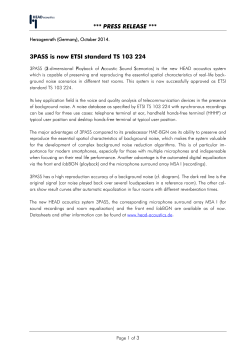
this article
It’s all ‘about that bass’ – or getting good sound from small speakers Getting great sounding products can be a difficult and time-consuming process for those unfamiliar with acoustic product design. In this article we offer the following hints and tips in designing the simplest type of loudspeaker enclosure the infinite baffle or closed box. Getting started Loudspeakers sound thin and tinny without a suitably designed enclosure; just try listening to any speaker in free space. The simplest enclosure is an air tight box, but beware if the box is too small the bass will sound boomy and shallow, whereas large boxes will produce deeper bass but may lead to high field returns of products with damaged speakers when they are over driven. You can take a trial and error approach to the enclosure design - we normally find manufacturers just fit their loudspeaker into the product enclosure and then find out how it sounds. Sometimes this works out, but often it leads to more expense and delays caused by the necessary mechanical design changes and resulting retesting before you find the right combination of speaker and box. However, there is a quicker and more scientific method! Back in the 1960’s and 70’s, Neville Thiele and Richard H. Small solved this problem by characterising the moving coil loudspeaker. Known as the Thiele and Small parameters, they enable the acoustic designer to predict the speakers’ low frequency performance, without resorting to using his carpentry skills. For a closed box enclosure, the Thiele and Small parameters you will need are: FS = the loudspeaker’s free air resonance (Hz). QTS = the loudspeaker’s resonance magnification at Fs. VAS = the loudspeaker’s compliance expressed as a volume (litres). You will also need to know: Loudspeaker’s sensitivity or loudness for a given power (dB @ 1m, for 1 Watt). Loudspeaker’s maximum power (Watts). Your amplifier’s maximum power (Watts). Mellow Acoustics Limited, 42 Hale Road, Farnham, Surrey, UK, GU9 9QH. Telephone: +44 7748 766444. Email: info@mellowacoustics.com Website: www.mellowacoustics.com Mellow Acoustics Limited is a company incorporated and registered in England and Wales with company number 7850109 whose registered office is at Mellow Acoustics Limited, 42 Hale Road, Farnham, Surrey, UK, GU9 9QH. The design process 1) Understand the background noise level your product works in - More noise, means a more powerful speaker is needed to overcome the back ground levels by at least 10dB! Hence a speaker operating in a vehicle will need higher sensitivity and power handling than one in a quiet office. Therefore it is likely to be more expensive as a result. Amplifiers will be higher power and need more battery/bigger power supplies too. To calculate the loudness at maximum power use:𝑆𝑃𝐿𝑚𝑎𝑥 = 𝑆𝑃𝐿𝑠𝑒𝑛𝑠𝑖𝑡𝑖𝑣𝑖𝑡𝑦 + 10. 𝐿𝑂𝐺10 𝑆𝑝𝑒𝑎𝑘𝑒𝑟𝑝𝑚𝑎𝑥 𝑑𝐵 𝑃𝑜𝑤𝑒𝑟𝑟𝑒𝑓 Note:- At low frequencies, it is the maximum cone excursion rather than power handling that limits the SPL. 2) Define what your product does – do you want speech or music, Lo-Fi or Hi-Fi reproduction? The bandwidth of basic speech is 300Hz – 3 KHz and high quality speech is 200Hz – 5 KHz whereas, Lo-Fi music is 300Hz – 10 KHz and Hi-Fi, 20Hz – 20 KHz! Once known, choose a loudspeaker able to produce the lowest and highest frequencies required (with Fs close to the lowest frequency) and loudness needed. 3) Calculating the enclosure volume necessary – the chosen enclosure volume VB will affect the bass resonant frequency fc and the amount it is boosted due to the compliance ratio α. We advise that α is set between 0.7 and 1.0 to avoid overdriving the loudspeaker whilst maximising the bass using the following formula:- Mellow Acoustics Limited, 42 Hale Road, Farnham, Surrey, UK, GU9 9QH. Telephone: +44 7748 766444. Email: info@mellowacoustics.com Website: www.mellowacoustics.com Mellow Acoustics Limited is a company incorporated and registered in England and Wales with company number 7850109 whose registered office is at Mellow Acoustics Limited, 42 Hale Road, Farnham, Surrey, UK, GU9 9QH. 𝑉𝐵 = 𝑉𝐴𝑆 α The resonant frequency of the system fc and lower bandwidth frequency f-3dB can be calculated as:𝑓𝑐 = √1 + 𝛼. 𝑓𝑠 𝑄𝑇𝐶 = √1 + 𝛼. 𝑄𝑇𝑆 f 3dB 1 fc 2 1 2QTC 1 2 1 2QTC 2 1 1 2 If the box volume is too large for your product, then you will need to look for a different speaker with a lower VAS. Unfortunately, this usually affects the loudspeaker’s Fs and hence the lowest frequency that can be reproduced, which probably means you are being too ambitious with the design and will need a larger loudspeaker! 4) Calculate the acoustic performance of your design – using the following formula, means you can calculate the loudness of the design at any frequency. 𝑆𝑃𝐿 = 10. 𝐿𝑂𝐺10 𝑓𝑟2 (𝑓𝑟 − 1)2 + ( 𝑓𝑟 2 ) 𝑄𝑇𝐶 𝑓 2 𝑤ℎ𝑒𝑟𝑒 𝑓𝑟 = ( ) 𝑓𝑐 Plotting the results from 20Hz to 20 KHz will give you a good idea of the acoustic performance of your design before you build it and could save you money and time too. 5) Build and test you product – you can make the back volume in almost any shape as long as it is airtight, including exiting holes for wires etc. We recommend you measure the acoustic response (if you have the equipment), before undertaking a listening test, just in case your design looks like this one (shown black) caused by leaks in the enclosure. Listening tests had been okay with music for the most part, but speech was unintelligible! Making an air tight seal and the enclosure the correct size of course solves these problems and produced the smooth frequency response (shown in red). Mellow Acoustics Limited, 42 Hale Road, Farnham, Surrey, UK, GU9 9QH. Telephone: +44 7748 766444. Email: info@mellowacoustics.com Website: www.mellowacoustics.com Mellow Acoustics Limited is a company incorporated and registered in England and Wales with company number 7850109 whose registered office is at Mellow Acoustics Limited, 42 Hale Road, Farnham, Surrey, UK, GU9 9QH. With these few simple tips, we hope your product is sounding great, but if you are struggling to fit your design into your product or need a little help designing something at little unusual we can help to:• • • • Shrink the enclosure size whilst maintaining the bass response. Add resonant chambers for sirens, enabling you to combine components and reduce costs. Improve audio quality with DSP. Add microphones to your product. For more information please contact us by email at info@mellowacoustics.com Mellow Acoustics Limited, 42 Hale Road, Farnham, Surrey, UK, GU9 9QH. Telephone: +44 7748 766444. Email: info@mellowacoustics.com Website: www.mellowacoustics.com Mellow Acoustics Limited is a company incorporated and registered in England and Wales with company number 7850109 whose registered office is at Mellow Acoustics Limited, 42 Hale Road, Farnham, Surrey, UK, GU9 9QH.
© Copyright 2025










